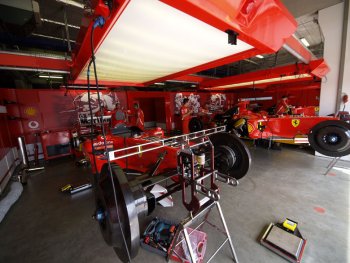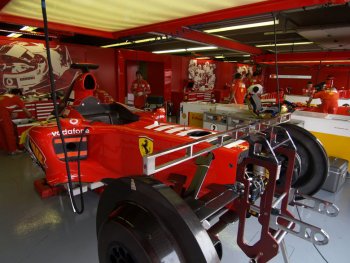|
With the cars
having been air-freighted directly from Montreal to
Indianapolis, Scuderia Ferrari Marlboro will be lining up
the same two F2005 for Michael Schumacher and Rubens
Barrichello in the US Grand Prix that they used in the
Canadian event.
The cars will be
completely rebuilt in the spacious garages at “The
Brickyard” as the Indianapolis circuit is known and settings
of all the key elements of the car –
engine-gearbox-suspension etc., will be modified to suit the
needs of this track. With most teams introducing new aero
packages for Montreal, aerodynamics is once again a key item
on the agenda this weekend.
But before
looking into the specific demands of this famous track,
Scuderia Ferrari Marlboro’s race aerodynamicist, Alex
Cinelli gives us an insight into the challenges presented by
the new rules concerning aerodynamics, brought into force
since the start of this year. In simple terms, aerodynamic
aids have been much reduced through changes to the front and
rear wings and the diffuser (the back part of the floor of
the car.)
Cinelli trained
in aeronautical engineering at London’s Imperial College and
after doing a Masters degree with Fiat at Turin, went
straight into a Formula 1 job with Tyrrell Racing, before
spending four years with Williams, prior to joining Ferrari
three years ago. In all his time as an aerodynamicist, the
2005 rules presented him and all his counterparts in other
teams, with one of the biggest challenges of the past few
years. “When the new rules were introduced, we got a big
shock because we lost a lot of car performance, so it has
been an interesting technical challenge trying to get back
as much performance as possible,” he says. “The loss of
performance varied from team to team and I think we were hit
quite hard, because our 2004 package had been so effective.
We have now recovered nearly all the lost downforce. We are
happy with the way we have been developing the car, but
there is still a way to go to reach the levels we had at the
end of 2004. It has opened up a lot of new ideas and paths
to follow.”
But there is no
“perfect” aerodynamic solution, therefore work in the wind
tunnel is a never ending process. “At the moment, there are
still a lot of gains to be had,” continues Cinelli. “The
work is never finite and there is always more to be had. It
is question of looking at all the areas in the car and
quantifying the loss, seeing how the balance of the car has
shifted and looking at the trade-off between downforce and
drag and how much efficiency one has lost.” In simple terms,
downforce is “good” aerodynamics in that it helps glue the
car to the road, while drag is “bad” downforce, as its
effect is to slow the car.
“With new rules, you have to
start afresh and look at different concepts, trying very
different things,” reveals Cinelli. “For example, before the
changes, the front wing was optimised for the rest of the
car, working with the turning vanes and the diffuser and it
was a nicely integrated package. Now the rear wing is in a
different position, the diffuser was affected, the front
wing was altered, so we had to come up with different ideas,
designing new parts and testing them. We made pretty big
steps initially and now we are fine tuning our current
package. All the teams look at one another’s cars and
everyone tries ideas they see on other cars, especially this
year with the new rules. But in the end you have to do what
is best for your car.”
Time to look at the specific aerodynamic dilemma that is the
Indianapolis circuit. Why a dilemma? Because the straight,
which is part of the famous banked oval, run in the opposite
direction to that used for the Indianapolis 500 Miles race,
provides at around 22 seconds, the longest flat-out section
of the season, while the rest of the track – the infield –
has some of the slowest turns of the year.
|
 |
|
The cars will be completely rebuilt in the spacious
garages at “The Brickyard” as the Indianapolis
circuit is known and settings of all the key
elements of the car – engine-gearbox-suspension,
will be modified to suit the needs of this
track |
|
|
 |
|
With the cars having been air-freighted directly
from Montreal to Indianapolis, Scuderia Ferrari will
be lining up the same two F2005 for Michael
Schumacher and Rubens Barrichello in the US
Grand Prix that they used
in Canada |
|
|
“Ideally in Indy, you want
a very small rear wing to give you the top speed on the
straight and a lot of wing on the infield, where you need
more downforce and are not so worried about drag, but of
course, you can only have one wing level,” theorises Cinelli.
Simulation programmes show that, in terms of actual lap
times, there is hardly any difference between running the
sort of wing level required to go quickly down the straight
and selecting a wing that provides more grip in the infield.
However, as Cinelli explains the realities of getting ahead
and staying ahead of other cars in the race is the
determining factor. “Our simulations and our past experience
go hand in hand when we decide what wing levels to run. In
terms of lap times the speed on the straight is very
important because it is so long. Plus, a driver who is quick
down the straights can maintain position or even pass other
cars and then, if his car has less downforce through the
infield and is therefore slow, he can still keep the other
cars behind him as it is very hard to pass in this section
of the track. Too much wing on the straight and you might
get overtaken.”
Downforce levels
are not decided in isolation. Everything from tyre choice to
engine configuration to suspension and strategy can affect
the aero package for any particular race. “We know what our
top speeds will be at Indy and when we decide on downforce
level for any race, we have simulations from our Vehicle
Dynamics department and our experience from previous years
at the track to rely on,” says Cinelli. “We factor in the
tyre situation when fine tuning the aero set up and also
consider brake and engine cooling. As aerodynamicists, we
want to run everything as closed as possible to maintain
aerodynamic efficiency, but we have to balance this against
the cooling requirements of the components.”
The length of
the pit straight means that Indianapolis provides the
perfect example of the slipstreaming phenomenon. In simple
terms, if one car follows another closely at high speed, the
front car punches a hole in the air, allowing the second car
to travel at the same speed while using less engine power
and it is thus able to pull out of the slipstream, apply
more power and overtake. However, the complex aerodynamics
on an F1 car means that the following car’s balance is upset
by this and either cannot get close enough to pass, or loses
downforce which can lead to loss of grip and a crash.
Indeed, in conjunction with the FIA, Ferrari carried out
tests at Monza a couple of years ago to see the effect of
one car following another closely and how the downforce loss
and drag reduction changes the nearer a driver gets to the
car in front. “We found that
the average air flow over the car is reduced,” says Cinelli.
“Air on the car creates dynamic pressure and if there is a
car in front of you, it has two effects. The air on the car
is reduced and so the car generates less downforce and the
air coming towards you is not “clean” it is turbulent. Cars
do not like that. As a car closes to the one in front, the
following car loses more downforce because of the turbulence
of the air and there is an upwash from the car in front so
air hits the car from an angle it is not designed to deal
with.”
Of course, none
of this theory matters to Ferrari drivers Michael Schumacher
and Rubens Barrichello in the heat of battle in the race.
They are simply concerned with controlling their F2005,
trying to anticipate any changes in grip levels, as they
battle with their rivals at some of the highest speeds seen
all season on the most famous race track in the world.
|
|
|
|
![]()
![]()